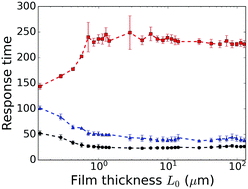Transient response and domain formation in electrically deforming liquid crystal networks†
Abstract
Recently, three distinct, well-separated transient regimes were discovered in the dynamics of the volume expansion of shape-shifting liquid crystal network films in response to the switching on of an alternating electric field [Van der Kooij et al., Nat. Commun., 2019, 10, 1]. Employing a spatially resolved, time-dependent Landau theory that couples local volume generation to the degree of orientational order of mesogens that are part of a viscoelastic network, we are able to offer a physical explanation for the existence of three time scales. We find that the initial response is dominated by overcoming the impact of thermal noise, after which the top of the film expands, followed by a permeation of this response into the bulk region. An important signature of our predictions is a significant dependence of the three time scales on the film thickness, where we observe a clear thin-film-to-bulk transition. The point of transition coincides with the emergence of spatial inhomogeneities in the bulk of the film in the form of domains separated by regions of suppressed expansion. This ultimately gives rise to variations in the steady-state overall expansion of the film and may lead to uncontrolled patterning. According to our model, domain formation can be suppressed by (1) decreasing the thickness of the as-prepared film, (2) increasing the linear dimensions of the mesogens, or (3) their degree of orientational order when cross-linked into the network. Our findings provide a handle to achieve finer control over the actuation of smart liquid crystal network coatings.



 Please wait while we load your content...
Please wait while we load your content...